


8 months ago
Ultra-detailed half body portrait of a desert-hardened woman in her mid 20s, sun-weathered skin with natural freckles across her cheeks and blemishes over her body, keen hazel eyes adapted to scanning distant horizons, dark hair wrapped in a practical sand-colored shemagh that protects her neck and lower face, wearing layered desert survival gear - a loose fitting crop top underneath a weathered open tactical vest, revealing a flat, toned belly with defed abs, outie belly button. She wears loose low rise pants and a belt with multiple water container attachments, UV-protective goggles pushed up on her forehead, standing amid the ruins of a massive oil refinery complex half-buried by endless dunes of golden sand, towering rusted distillation columns rising like ancient monoliths from the desert floor, heat waves visibly distorting the air around corroded pipeline networks that snake through the dunes, scattered remnants of industrial machinery emerging from shifting sands - partially buried pressure vessels, sand-scoured storage tanks, and wind-polished metal structures, intense sunlight casting harsh shadows across her face through gaps in the deteriorating industrial framework, sand particles catching the light as they drift through the air, multiple layers of desert-industrial decay visible in the background - collapsed cooling towers creating artificial canyons, sand-filled processing units, and sun-bleached warning signs barely visible under layers of dust, abandoned vehicles half-submerged in sand drifts, occasional glints of metal where the wind has exposed buried equipment, photorealistic rendering with attention to material interactions between sand and metal - wind-polished surfaces, sand-carved patterns in steel, and sun-damaged materials, 8k resolution emphasizing the texture of each weather-beaten surface, technical perspective showing the massive scale of the industrial remains against the endless desert horizon, visible heat distortion in the distance where sky meets sand, subtle color variations in the sand showing mineral content and age of dune

8 months ago
Half body portrait of a young woman with tattered clothing wit a clearly visible flat, toned belly and a well defined sixpack abs, standing against a decaying cityscape, harsh neon lights casting shadows across her face, volumetric fog, cyberpunk atmosphere, visible air pollution, broken holographic advertisements in background, ultra detailed, cinematic lighting, 8k, hyperrealistic, photorealistic, high contrast, depth of field, award winning photography

8 months ago
"A first-person perspective of Spider-Man waking up in his small New York apartment. His legs, fully covered in the iconic red and blue Spider-Man suit, are stretched out on the bed, with his feet resting on the slightly messy sheets. The suit's sleek fabric clings to his form, with web patterns and subtle folds creating a realistic texture. Morning sunlight filters through the window, casting soft shadows on the floor. His mask lies crumpled on the nightstand, next to his buzzing smartphone showing missed messages. The room is cluttered with books, gadgets, and a half-eaten pizza from last night. The atmosphere is highly realistic, with soft lighting, detailed textures, and an urban morning ambiance."

8 months ago
dystopian style Close-up half body shot (from a drone flying High Angle from the right above the subject:1.5) of a 24-year-old woman with long black messy hair standing in a dystopian desert, looking directly into the camera of the drone. Her hands in fingerless gloves with metal knuckles, clenched into fists, she stands tensly in a defencive position. Thin, fit and muscular physique like someone who fights daily for survival, she stands dressed in a sleeveless orange/reddish top which displays her flat toned belly, visible abs. A kufiya wrapped around her neck, worn utility pants and worn brown leather boots Armed for survival with a utility belt with pouches containing survival tools, Several throwing knives visible in ankle sheaths. Her arms are covered with tattos an in one shoulder a huge bloody scar. far in the Background a post-apocalyptic deserted urban environment. Her alert posture and scanning gaze suggest constant vigilance, muscles tensed ready for action. Harsh lighting creating shadows that accentuate her muscular definition, desaturated color palette with occasional rust tones, cinematic composition, hyperrealistic details, 8k quality . bleak, post-apocalyptic, somber, dramatic, highly detailed

7 months ago
a professional photo of a exceptionally of the most beautiful Japanese girl in the world, (age 11), Safiya (futuristic),(masterpiece), (realistic), (perfect anatomy), flawless dark olive skin, large beautiful brilliant Forest Tea green-blue-pink-silver-brown-golden eyes, black eye liner, light pink blush, dark black eye shadow, small dimples in cheeks very long black, white highlighted, half braided hair, (dressed as a ninja warrior) standing in a tropical forest, Rapier sword, strapped to her back, (8k), (high res),ultra-detailed, photo-realistic, front view, highly detailed, volumetric, dramatic light Perfect graphics, ultra-detailed, photo-realistic, full image view, full body view, front view

7 months ago
Abstract Full-Body Portrait of a Prostitute – Salvador Dalí (Late-Life Style, Singular Focus & Pure Surrealism) (Surrealism:1.7, Salvador Dalí late-life style:2.0, Dreamlike distortion:1.6, Hyperreal textures:1.5, Chiaroscuro contrast:1.4, Oil-painting brushstrokes:1.5, Organic fluidity:1.6, Metaphysical realism:1.4) A full-body surrealist portrait of a prostitute, painted in the unmistakable late-life style of Salvador Dalí, where dream logic dictates form and reality bends into its own subconscious reflection. She stands alone in the void, a lone figure frozen in motion yet melting into time itself. Her body is elongated but coherent, her limbs refined into one singular, fluid, organic motion, as if she is a sculpture made of half-formed candle wax, melting at the edges but never fully dissolving. Her face remains untouched by distortion, hyperreal and melancholic, eyes darkened with kohl, staring directly outward, unblinking, as if confronting time, fate, and the fabric of reality itself. A single strand of jet-black hair escapes from her carefully pinned curls, swaying in an invisible breeze. Her lips—painted a deep, blood-red—drip slightly at the edges, as if smeared by unseen hands, caught between seduction and sorrow. Her dress, a relic of the past, is a contradiction of luxury and decay, the hem transforming into thin wisps of smoke, curling and dispersing into the canvas. The fabric is stretched unnaturally, its folds elongating like the melted forms of Dalí’s classic clocks, one shoulder slipping in an eternal descent, never quite falling. The setting is an infinite, surreal landscape—a lonely street with no visible end, where shadows stretch longer than their owners, and the cobblestones appear to melt into liquid mercury. In the background, a large, antique pocket watch, twisted and partially submerged in the air, hangs frozen at an uncertain hour, its hands warped into elongated spirals. A single red rose, impossibly large and impossibly alive, hovers just behind her, its petals peeling away like fragments of forgotten love letters. The air feels thick, painted with visible brushstrokes, where light and shadow do not obey the laws of physics—instead, they bleed into one another, wrapping around her body in soft, liquid chiaroscuro, mimicking the curvature of a dream. She is not merely a woman but a symbol—of desire, of loss, of something slipping through time like sand through Dalí’s own fingers.

8 months ago
Ultra-detailed half body portrait of a 24 year woman, bearing a prominent facial scar that cuts across her left cheek - a mark of survival in countless street fights, cold calculating eyes that hold both cunning and cruelty, angular features hardened by years of combat, short black hair styled practically with an undercut to prevent opponents from gaining advantage, wearing an expensive business jacket, open showing a heavily cropped business shirt, which barely covers her breasts, showing her flat toned belly with defined sixpack abs, standing in a luxurious penthouse office overlooking a brutalist cityscape of imposing concrete and steel structures, the window behind her showcasing the stark wealth divide - opulent high-rises crowned with neon-lit fighting arenas adjacent to crumbling tenements where the weak struggle to survive, private security forces visible patrolling elevated walkways, smoke rising from illegal fighting pits in the lower levels, multiple layers of corrupt authority visible through the glass - private military contractors guarding corporate territories, street gangs marking their domains with holographic tags, expensive hover-vehicles carrying crime lords between their territories, harsh artificial lighting from corporate logos casting blood-red shadows across her face, reflective surfaces showing both luxury and defensive capabilities - bulletproof windows and concealed weapon systems, photorealistic rendering in ultra-high detail capturing both the sleek modern technology and the underlying violence of society, 8k resolution with emphasis on material contrasts between expensive synthetics and crude street-level modifications, detailed attention to status symbols of power - augmented strength visible in subtle cybernetic enhancement scars at her wrists, trophy rings from defeated opponents adorning her fingers, a championship fighter's medallion worn as a subtle threat display, environmental storytelling showing the mechanics of power - security checkpoints, combat betting stations, and medical repair facilities for the wealthy fighters who can afford them
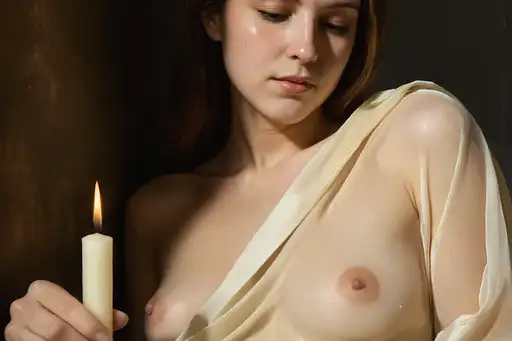
4 months ago
diaphanous ivory robe slipping off one shoulder::1.4 dramatic chiaroscuro with deep shadow enveloping half her form and a single candlelit god-ray grazing her face::1.6 oil on canvas in the style of Caravaggio::1.7 fine yet bold brushwork capturing glint on the camera lens, rich ochres and burnished umbers in the background::1.5

9 months ago
A half-body portrait in Jarmusch's nocturnal style: A woman poses in the back room of an underground vinyl record store, surrounded by stacks of albums. The frame captures her from mid-thigh up, standing amid towers of vintage records. She wears a worn-in black denim jacket over a faded cropped band t-shirt its print barely discernible in the low light, showing a toned, flat belly with clearly visible abs. The scene is predominantly black and white, but with subtle hints of midnight blue from a neon 'JAZZ' sign partially visible through beaded curtains. Warm sepia tones emerge from the aged record sleeves, creating gentle color accents in the shadows. The lighting is soft and diffused, coming from a single bare bulb above, casting gentle shadows that trace the geometric patterns of the record stacks. Her pose is natural, perhaps mid-conversation or selecting a record, capturing that unguarded Jarmusch moment between actions. Shot with characteristic depth and richness in the blacks, while maintaining detail in the shadows to reveal the texture of the vinyl covers and worn denim.

4 months ago
A tight close-up, black and white, side view of an African American woman's lower face, emphasizing her mouth and lips. The image is a black and white close-up, cropped to show only the lower half of a woman's face from a side angle, focusing on her mouth and prominent lips. Her darkly colored lips appear full and slightly open, revealing a glimpse of her teeth. They are highlighted with a shimmering effect, possibly from lip gloss or glitter. The skin around her mouth, including her chin and the area above her upper lip, shows fine details, including visible pores and light stubble or peach fuzz. There is a hint of what appears to be sunglasses in the upper portion of the image, framing the top of her nose and cheek area. The lighting is dramatic, with harsh shadows and highlights that emphasize the texture of her skin and the contours of her mouth. The background is a white, featureless expanse. The atmosphere is intense and alluring, with a mood that feels both intimate and slightly mysterious due to the close crop and dark shadows.

8 months ago
(Full-body shot, fine art noir photography, 1950s–1960s vintage setting, cinematic chiaroscuro lighting, ultra-realistic rendering, moody and atmospheric, sensual yet elegant, masterful composition, soft film grain, rich textures, timeless erotica aesthetic) A seductive nude woman stands in a dimly lit 1950s boudoir, her back to the camera, the curve of her spine accentuated by the flickering glow of a single vintage table lamp. A lush black fur boa drapes across her bare shoulders, cascading down her arms, its luxurious texture framing the smooth, radiant skin beneath. Silk stockings hug her legs, their delicate sheen catching the ambient light, a subtle garter barely visible. Her posture is both effortless and deliberate, hips slightly tilted, her weight shifted onto one foot, evoking a raw yet refined sensuality. A hazy mirror reflects just enough of her face in profile, lips painted a deep red, parted slightly as she gazes at her own reflection—lost in thought, desire, or a silent secret only she knows. The room exudes mid-century allure—a velvet chaise lounge, a half-empty glass of whiskey on a dark wood vanity, soft shadows stretching across plush drapes and antique furniture. The atmosphere is thick with desire, erotic yet sophisticated, a scene torn from the golden age of film noir where temptation lingers in the air, and every detail whispers luxury, mystery, and seduction.
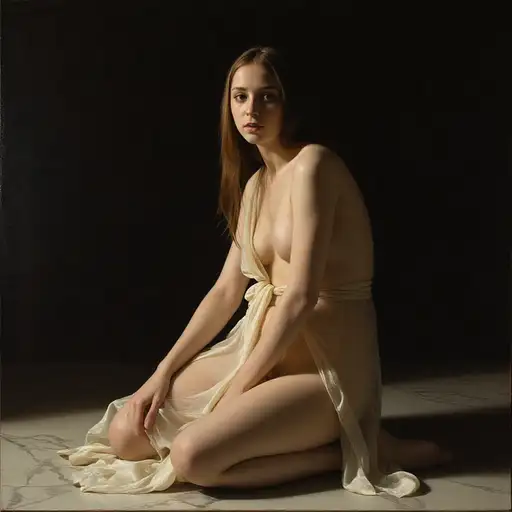
4 months ago
diaphanous ivory robe slipping off one shoulder::1.4 dramatic chiaroscuro with deep shadow enveloping half her form and a single candlelit god-ray grazing her face::1.6 oil on canvas in the style of Caravaggio::1.7 fine yet bold brushwork capturing glint on the camera lens, rich ochres and burnished umbers in the background::1.5

9 months ago
Masterpiece, masterful composition, awe-striking, chef d'oeuvre, photorealistic grain. A stunning full-body portrait of a beautiful alluring young European woman sat in a comfy sofa in her apartment. She's drinking from a hot cup in the unlit shadows of early morning. She has long night-blue unkempt drenched hair with carefully styled rainbow braids, grey blue eyes, with some dark make-up around, a small pointy nose. The apartment is in the shadows. She wears a greyish blue hoodie with fluffy padding over a black sleeveless sports top, grey sweat pants, no shoes. She has silver earrings with rainbow shiny pearls that shine in the half-night. by eryn. Her skin is pinkish white with some old whitish scars visible on her thighs and arms. Around her in the room are a cloth rainbow handbag, party clothes, knee-high boots on the floor, a few books out of numerous bookshelves just lying here and there on tables and whatnot. She seems tired. Warm night palette. Very intricate patterns. Striking graceful melancholic atmosphere all over.
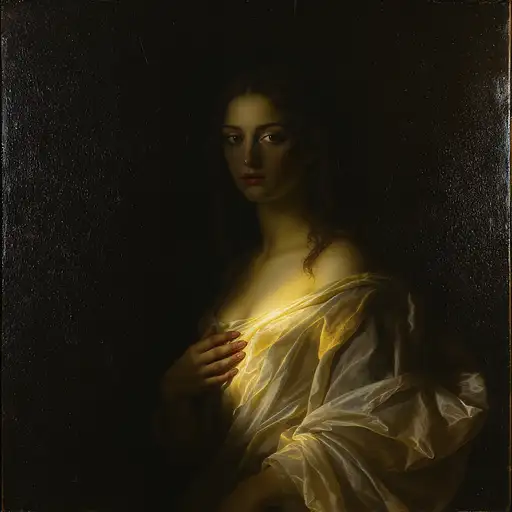
4 months ago
diaphanous ivory robe slipping off one shoulder::1.4 dramatic chiaroscuro with deep shadow enveloping half her form and a single candlelit god-ray grazing her face::1.6 oil on canvas in the style of Caravaggio::1.7 fine yet bold brushwork capturing glint on the camera lens, rich ochres and burnished umbers in the background::1.5

7 months ago
a professional photo of a exceptionally of the most beautiful Japanese girl in the world, (age 11), Safiya (futuristic),(masterpiece), (realistic), (perfect anatomy), flawless dark olive skin, large beautiful brilliant Forest Tea green-blue-pink-silver-brown-golden eyes, black eye liner, light pink blush, dark black eye shadow, small dimples in cheeks very long black, white highlighted, half braided hair, (dressed as a ninja warrior) standing in a tropical forest, Rapier sword, strapped to her back, (8k), (high res),ultra-detailed, photo-realistic, front view, highly detailed, volumetric, dramatic light Perfect graphics, ultra-detailed, photo-realistic, full image view, full body view, front view

5 months ago
(Full-body shot, fine art noir photography, 1950s–1960s vintage setting, cinematic chiaroscuro lighting, ultra-realistic rendering, moody and atmospheric, sensual yet elegant, masterful composition, soft film grain, rich textures, timeless erotica aesthetic) A seductive nude woman stands in a dimly lit 1950s boudoir, her back to the camera, the curve of her spine accentuated by the flickering glow of a single vintage table lamp. A lush black fur boa drapes across her bare shoulders, cascading down her arms, its luxurious texture framing the smooth, radiant skin beneath. Silk stockings hug her legs, their delicate sheen catching the ambient light, a subtle garter barely visible. Her posture is both effortless and deliberate, hips slightly tilted, her weight shifted onto one foot, evoking a raw yet refined sensuality. A hazy mirror reflects just enough of her face in profile, lips painted a deep red, parted slightly as she gazes at her own reflection—lost in thought, desire, or a silent secret only she knows. The room exudes mid-century allure—a velvet chaise lounge, a half-empty glass of whiskey on a dark wood vanity, soft shadows stretching across plush drapes and antique furniture. The atmosphere is thick with desire, erotic yet sophisticated, a scene torn from the golden age of film noir where temptation lingers in the air, and every detail whispers luxury, mystery, and seduction.
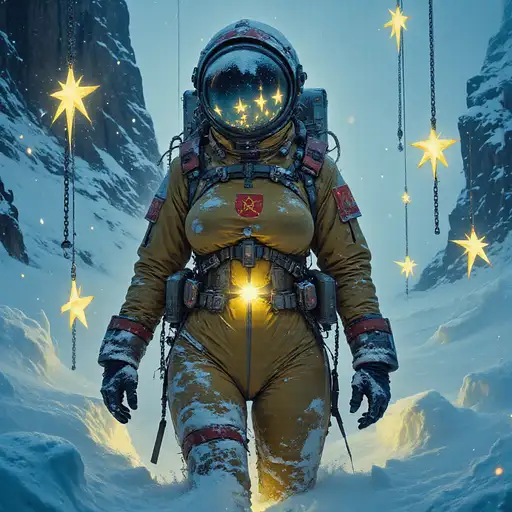
2 months ago
(A hyper-realistic, masterpiece-level color photograph:1.3) of a woman in a Soviet-style retrofuturistic spacesuit (Soviet retrofuturism:1.5) standing in the icy expanse of the Arctic during a fierce blizzard (blizzard in the Arctic:1.4). The woman’s suit, weathered and bulky, bears the clear red insignia of CCCP across the chest (CCCP insignia:1.5), adding to the harsh, militaristic aesthetic of the scene. The spacesuit has a Cold War-era design, with bold red accents and a heavy, utilitarian build, blending the futuristic with the gritty, industrial style of the Soviet Union. Surrounding her, several small, glowing stars float tethered by thick industrial chains (tethered glowing stars in a blizzard:1.4). These stars cut through the blizzard, casting yellow light that glows eerily against the swirling snow. The stars, connected to the icy ground by chains, sway violently in the wind, their light creating dynamic volumetric beams as they fight against the storm. The woman’s helmet visor reflects the glowing stars and the chaos of the blizzard around her, casting intricate patterns of light across her suit, which is half-covered in snow and ice. The volumetric lighting from the stars pierces the thick snowstorm, illuminating the drifting snowflakes and casting long, dramatic shadows across the snowy landscape. The environment is harsh and unforgiving—her spacesuit is covered in frost, and the cold, biting wind whips at her, while snow drifts build up around her legs. The blizzard creates an intense sense of motion, with the snow swirling around in unpredictable patterns, making it feel as though the woman is standing in the heart of a Soviet Arctic research mission gone wrong. Amidst the storm, the CCCP insignia glows faintly under the light of the stars, a symbol of the lost Soviet expedition. The glowing stars and industrial chains are tethered to the icy ground, creating a surreal, otherworldly scene in the middle of this brutal landscape. The scene is a combination of retrofuturistic design and gritty realism, with the harshness of the blizzard contrasting against the surreal glow of the stars. The intense lighting from the stars and the complex shadows they cast against the swirling snow create a dramatic, cinematic atmosphere. The overall mood is cold, brutal, and haunting, capturing a moment of isolation and survival in the Soviet retrofuturistic Arctic wasteland

7 months ago
Half body portrait of a young woman with tattered clothing wit a clearly visible flat, toned belly and a well defined sixpack abs, standing against a decaying cityscape, harsh neon lights casting shadows across her face, volumetric fog, cyberpunk atmosphere, visible air pollution, broken holographic advertisements in background, ultra detailed, cinematic lighting, 8k, hyperrealistic, photorealistic, high contrast, depth of field, award winning photography

8 months ago
A barren, sun-scorched world stretches before you, its landscape dotted with the skeletal remains of a once-thriving civilization. Crumbling stone structures, half-buried in dust, hint at a forgotten people whose voices have long since faded into the silence of time. The twin suns cast an eerie golden glow over the ruins, creating long shadows that dance across the cracked earth. At the heart of the desolation, a single artifact remains untouched—a delicate wooden flute, resting on a worn stone pedestal, its surface smoothed by the passage of centuries. The wind carries a ghostly echo of music, a melody that no living soul has played in a thousand years. Faint spectral figures flicker in the distance, their outlines shimmering like heat mirages—glimpses of the past, moments frozen in time. This is a place where history lingers, unseen yet deeply felt. The silence is deafening, yet the weight of an entire civilization’s hopes, dreams, and love is imprinted in every grain of sand. This is not just a ruin; it is a graveyard of memory, a testament to the fleeting nature of existence. Depict the melancholy beauty of this forgotten world, emphasizing the contrast between the endless march of time and the fragile permanence of a single, cherished melody.

8 months ago
Spider-Man in an epic battle against a massive Snake Monster in a dark, urban setting. The scene is set in an abandoned warehouse, with dim, dramatic lighting and shadows stretching across the floor. Spider-Man is in mid-air, swinging with his web-shooters aimed at the monster. The Snake Monster is enormous, with shimmering, reptilian scales and glowing eyes. Its long, coiling body is half-wrapped around a pillar, and its venomous fangs are bared. Spider-Man’s suit is in full detail, with his signature red and blue design, and his posture shows agility and determination. The monster’s tail is swiping through the air, creating a sense of motion and danger. The environment has broken crates and debris, adding to the chaotic feel of the battle. The lighting casts a dramatic glow on Spider-Man’s face, highlighting his focus as he faces the formidable beast.

7 months ago
High fashion half body photo of a 25 year old asian female supermodel, very thin, small breast, flat chest, abs, with short messy black hair, Sweater Ponchos, midriff, Vintage Denim Shorts, Holding a drink in one hand , rule of thirds, in the background Art galleries with raw spaces, lights Backlighting with shadow details the model is lighted with Overcast sky in the style of Steven Meisel
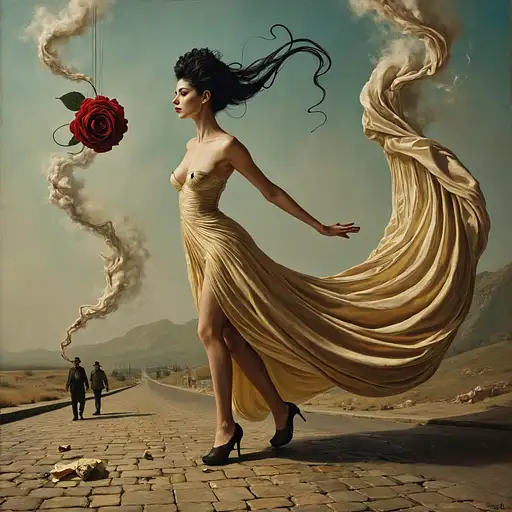
7 months ago
(Surrealism:1.7, Salvador Dalí late-life style:2.0, Dreamlike distortion:1.6, Hyperreal textures:1.5, Chiaroscuro contrast:1.4, Oil-painting brushstrokes:1.5, Organic fluidity:1.6, Metaphysical realism:1.4) A full-body surrealist portrait of a prostitute, painted in the unmistakable late-life style of Salvador Dalí, where dream logic dictates form and reality bends into its own subconscious reflection. She stands alone in the void, a lone figure frozen in motion yet melting into time itself. Her body is elongated but coherent, her limbs refined into one singular, fluid, organic motion, as if she is a sculpture made of half-formed candle wax, melting at the edges but never fully dissolving. Her face remains untouched by distortion, hyperreal and melancholic, eyes darkened with kohl, staring directly outward, unblinking, as if confronting time, fate, and the fabric of reality itself. A single strand of jet-black hair escapes from her carefully pinned curls, swaying in an invisible breeze. Her lips—painted a deep, blood-red—drip slightly at the edges, as if smeared by unseen hands, caught between seduction and sorrow. Her dress, a relic of the past, is a contradiction of luxury and decay, the hem transforming into thin wisps of smoke, curling and dispersing into the canvas. The fabric is stretched unnaturally, its folds elongating like the melted forms of Dalí’s classic clocks, one shoulder slipping in an eternal descent, never quite falling. The setting is an infinite, surreal landscape—a lonely street with no visible end, where shadows stretch longer than their owners, and the cobblestones appear to melt into liquid mercury. In the background, a large, antique pocket watch, twisted and partially submerged in the air, hangs frozen at an uncertain hour, its hands warped into elongated spirals. A single red rose, impossibly large and impossibly alive, hovers just behind her, its petals peeling away like fragments of forgotten love letters. The air feels thick, painted with visible brushstrokes, where light and shadow do not obey the laws of physics—instead, they bleed into one another, wrapping around her body in soft, liquid chiaroscuro, mimicking the curvature of a dream. She is not merely a woman but a symbol—of desire, of loss, of something slipping through time like sand through Dalí’s own fingers.

6 months ago
"The Colossus Beneath the Desert" – (Primary Subject: Titanic Buried Giant Stirring Beneath Sand Dunes, 1.7 weight) — deep in an endless, wind-scoured desert, a vast ancient colossus lies half-submerged beneath dunes of golden sand, its face cracked and weathered, sculpted from stone and bone. One glowing eye now flickers to life for the first time in ten thousand years, casting a pillar of blue light through the dust-choked sky. It is waking. The scale is impossible—ridges of sand ripple for miles outward with each breath it takes. What appears to be mountains on the horizon are the curved tips of its buried fingers, slowly flexing. Its ribs form deep canyons, home to temples built by forgotten civilizations who once worshipped it as god, jailer, and weapon. Above it, a caravan of nomads has stopped. Their camels rear back in fear. The elders whisper old songs once thought metaphor. A solitary figure in ceremonial robes walks toward the eye, chanting in forgotten tongues, holding a staff that glows faintly in resonance. This is not a confrontation. It is a negotiation. The sky roils with duststorms, lit orange and violet by the setting sun. Shadows stretch long across the sand, wrapping the moment in mythic stillness. Massive stone anklets and rune-bound chains anchor the colossus deep below—their glyphs eroded, weakened. A sandstorm gathers behind it, as if the world resists its rising. Its skin is made of layered strata and fossilized memory, carved with glowing runes that flicker like fault lines. When it exhales, the wind shifts continents. Its breath is heavy with salt, iron, and ancient sound. The desert listens. Rendered in epic cinematic realism, with sweeping scale, warm atmospheric tones, and deep contrast between golden sand, cold stone, and glowing eyes. Shot through a dusty anamorphic lens, grain visible in the low sun, with volumetric light shafts and wide mythic framing. Think Dune x Dark Souls x ancient Mesopotamian apocalypse (monumental visual drama, 1.4 weight).
